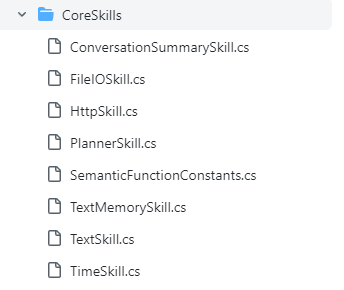

Semantic Kernel 入门系列:💾Native Function - 宵伯特
source link: https://www.cnblogs.com/xbotter/p/semantic_kernel_introduction_native_function.html
Go to the source link to view the article. You can view the picture content, updated content and better typesetting reading experience. If the link is broken, please click the button below to view the snapshot at that time.

Semantic Kernel 入门系列:💾Native Function

语义的归语义,语法的归语法。
最基本的Native Function定义只需要在方法上添加 SKFunction 的特性即可。
using Microsoft.SemanticKernel.SkillDefinition;using Microsoft.SemanticKernel.Orchestration; namespace MySkillsDirectory; public class MyCSharpSkill{ [SKFunction("Return the first row of a qwerty keyboard")] public string Qwerty(string input) { return "qwertyuiop"; } [SKFunction("Return a string that's duplicated")] public string DupDup(string text) { return text + text; }}
默认情况下只需要传递一个string 参数就行,如果需要多个参数的话,和Semantic Function一样,也是使用Context,不过这里传进去是 SKContext。在方法上使用 SKFunctionContextParameter声明一下参数,可以提供一定的说明,同时的有需要的话,可以设置参数的默认值。
using Microsoft.SemanticKernel.SkillDefinition;using Microsoft.SemanticKernel.Orchestration; namespace MySkillsDirectory; public class MyCSharpSkill{ [SKFunction("Return a string that's duplicated")] public string DupDup(string text) { return text + text; } [SKFunction("Joins a first and last name together")] [SKFunctionContextParameter(Name = "firstname", Description = "Informal name you use")] [SKFunctionContextParameter(Name = "lastname", Description = "More formal name you use")] public string FullNamer(SKContext context) { return context["firstname"] + " " + context["lastname"]; }}
调用的时候,一样使用 ContextVariables.
using Microsoft.SemanticKernel;using Microsoft.SemanticKernel.Orchestration; using MySkillsDirectory; // ... instantiate a kernel as myKernel var myContext = new ContextVariables(); myContext.Set("firstname","Sam");myContext.Set("lastname","Appdev"); var myCshSkill = myKernel.ImportSkill ( new MyCSharpSkill(), "MyCSharpSkill");var myOutput = await myKernel.RunAsync(myContext,myCshSkill["FullNamer"]); Console.WriteLine(myOutput);
当然异步的方法也是支持的。这样的话,就可以处理一些像是网络请求,数据库访问、文件读写等操作了。
using Microsoft.SemanticKernel.SkillDefinition;using Microsoft.SemanticKernel.Orchestration; public class MyCSharpSkill{ [SKFunction("Return the first row of a qwerty keyboard")] public string Qwerty(string input) { return "qwertyuiop"; } [SKFunction("Return the second row of a qwerty keyboard")] [SKFunctionName("Asdfg")] public async Task<string> AsdfgAsync(string input) { await ...do something asynchronous... return "asdfghjkl"; }
这里针对 AsdfgAsync 添加了一个 SKFunctionName 的特性,主要是为了使Function name 好看一些,避免 MyCSharpSkill.AsdfgAsync 这样。
和 Semantic Function中能够调用 Native Function一样,在 Native Function也可以调用Semantic Function,其中主要使用的还是 SKContext.
using Microsoft.SemanticKernel.SkillDefinition;using Microsoft.SemanticKernel.Orchestration; namespace MySkillsDirectory; public class MyCSharpSkill{ [SKFunction("Tell me a joke in one line of text")] [SKFunctionName("TellAJokeInOneLine")] public async Task<string> TellAJokeInOneLineAsync(SKContext context) { // Fetch a semantic function previously loaded into the kernel ISKFunction joker1 = context.Func("funSkill", "joker"); // OR Fetch a semantic function previously loaded into the kernel ISKFunction joker2 = context.Skills.GetSemanticFunction("funSkill", "joker"); var joke = await joker1.InvokeAsync(); return joke.Result.ReplaceLineEndings(" "); }}
这里并没有限制是 Semantic Function 还是Native Function,所以甚至可以完全使用Native Function编排技能调用,除了参数的定义和提取有些费劲以外,其他的几乎没什么问题,毕竟返回值都是string,这也就贯彻了Text is the universal wire protocol,即便是代码也得将就一下。
一些核心技能
Semantic Kernel 中大部分的能力都是有技能提供的,例如Semantic Kernel的一个核心组件Planner,其实就是一个Semantic Skill,另外官方提供了一些Core SKill,基本是日常比较常用的。具体可以参考https://github.com/microsoft/semantic-kernel/tree/main/dotnet/src/SemanticKernel/CoreSkills

和自行定义的Native Function一样的,只需要使用ImportSkill就行了
using Microsoft.SemanticKernel.CoreSkills; // ( You want to instantiate a kernel and configure it first ) myKernel.ImportSkill(new TimeSkill(), "time"); const string ThePromptTemplate = @"Today is: {{time.Date}}Current time is: {{time.Time}} Answer to the following questions using JSON syntax, including the data used.Is it morning, afternoon, evening, or night (morning/afternoon/evening/night)?Is it weekend time (weekend/not weekend)?"; var myKindOfDay = myKernel.CreateSemanticFunction(ThePromptTemplate, maxTokens: 150); var myOutput = await myKindOfDay.InvokeAsync();Console.WriteLine(myOutput);
至此,Semantic Kernel 的基础能力就学习得差不多了。
参考资料:
Recommend
-
 51
51
-
 46
46
谢邀~希尔伯特空间(Hilbert space)指的其实就是完备的内积空间(Complete inner product space),两者…
-
 8
8
活动作品子弹都打不碎的鲁伯特之泪再次遇上液压机,会怎样呢?129.3万播放 · 2757弹幕2021-05-24 08:02:25 全站排行榜最高第54名 ...
-
 8
8
Semantic Kernel 入门系列:🔥Kernel 内核和🧂Skills 技能 ...
-
 4
4
如果把提示词也算作一种代码的话,那么语义技能所带来的将会是全新编程方式,自然语言...
-
 8
8
无尽的上下文 LLM对自然语言的理解和掌握在知识内容的解...
-
 10
10
Semantic Kernel 入门系列:🍋Connector连接器 ...
-
 6
6
Semantic Kernel 的一个核心能力就是实现“目标导向”的AI应用。 “目标导向”听起...
-
 6
6
Kernel Memory 入门:Quick Start 了解了用户问答和文档预处理的流程之后,我们就可以直接开始使用Kernel Memory了。 项目中只需要通过NuGet安装Microsoft.KernelMemory.Core包即可。
-
 7
7
Kernel Memory 入门系列:Semantic Kernel 插件 Kernel Memory 本身提供了完整的RAG能力,这部分能力如果通过Semantic Kernel Memory的话,也是可以实现的,但是整体的管理成本会比较高。 因此通过K...
About Joyk
Aggregate valuable and interesting links.
Joyk means Joy of geeK